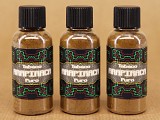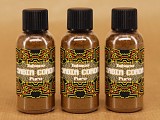Pot, 60 Ml, 30 Gr from Brazil (SKU 3912)
Tabaco de Moi powder is highly sought after in the production of Rapé. Its mild flavor and grounding effects make it an ideal choice for those seeking clarity, focus, and a connection to the earth during spiritual practices. The sweet aftertaste and pleasant aroma contribute to a refined, gentle Rapé experience, making it a popular choice for those who prefer a more balanced, uplifting blend. The finely ground powder is perfect for crafting personal Rapé blends. When combined with ashes in a simple 50-50 ratio, it produces a powerful yet harmonious Rapé, reminiscent of the traditional blends used by indigenous tribes throughout South America. Detailed information can be found below.
Packed in 60 ml clear plastic pots containing 30 gr.
| change currency | |||||||||
| SKU | Part | Volume | Weight | Unit | Price | Qty
|
|||
|---|---|---|---|---|---|---|---|---|---|
| 3217 | bottle | 10 ml | 6 gr | 1 pc | $ 6.23 | ||||
| 3912 | pot | 60 ml | 30 gr | 1 pc | $ 28.97 | ||||
| 4531 | pot | 100 ml | 50 gr | 1 pc | $ 42.83 | ||||
Tabaco de Moi, also referred to as Fumo de Rolo, is a unique variety of Nicotiana rustica, renowned for its sweet, mild aroma and deep cultural roots in the Amazon region of Brazil. This exceptional Tabaco is highly prized for its rich, solid, and dark appearance, offering a robust yet gentle flavor. Cultivated organically in the upper Jurua region of Acre, Brazil, this Tabaco is a testament to the craftsmanship passed down through generations of indigenous communities and Tabaco farmers.
The origins of Tabaco de Moi trace back to the early 20th century, during the rubber boom in the Amazon. Northeastern Brazilians, known as "soldados da borracha" (rubber soldiers), migrated to Acre, bringing Tabaco seeds from their homeland, where Tabaco cultivation was deeply rooted in tradition. Over time, these seeds were likely crossbred with native Amazonian strains, resulting in the unique Moi variety that exists today.
The name "Moi" comes from the Portuguese word "moles," which originally referred to bundles of Tabaco leaves intertwined to survive long sea voyages. Over time, the term evolved into "Moi", representing this special Tabaco. Fumo de Rolo, the broader term used across Brazil, describes the traditional method of rolling Tabaco leaves into dense, cylindrical ropes.
Tabaco de Moi is grown organically in the Amazon rainforest, without the use of chemicals or pesticides. The plants are naturally resilient and contribute to soil fertility, aligning with sustainable farming practices. After being harvested, the leaves are dried in the shade to retain their natural oils and flavors. Unlike other varieties, the central leaf grain is left intact during the drying process, contributing to the dense and solid structure that defines Moi Tabaco.
Once dried, the leaves are skillfully twisted into tight ropes using natural materials such as tree bark or strings. These ropes are then left to ferment for several months, allowing the flavor to deepen and the color to darken into a rich, dark brown or nearly black appearance. The result is a Tabaco with a unique sticky, dense texture that reflects its extended fermentation and meticulous craftsmanship.
As a Nicotiana rustica variety, Tabaco de Moi is distinguished by its dense, solid ropes and dark, sticky leaves. The ropes are longer and more tightly packed compared to similar varieties like Peruvian Mapacho, with a diameter of about 6-7 cm and lengths reaching 100 cm. The leaves carry a mild sweetness, earthy undertones, and an aromatic profile that makes them ideal for use in Rapé.
Tabaco de Moi powder is highly sought after in the production of Rapé, a sacred snuff used by many indigenous tribes in the Amazon. Its mild flavor and grounding effects make it an ideal choice for those seeking clarity, focus, and a connection to the earth during spiritual practices. The sweet aftertaste and pleasant aroma contribute to a refined, gentle Rapé experience, making it a popular choice for those who prefer a more balanced, uplifting blend.
The process of transforming Tabaco de Moi into a fine powder is a labor of love. First, the fermented Tabaco is sun-dried, carefully deveined, and ground into a fine powder. This powder is sieved multiple times to achieve the finest texture. The result is an extremely smooth, dry powder perfect for personal Rapé preparations.
The Tabaco powder made from Moi Tabaco can be mixed with various ashes, such as Tsunu or Parica, to create a powerful yet stable Rapé blend. When used in a 50-50 ratio with ashes, the resulting Rapé can offer both sharpness and grounding effects, similar to those made by indigenous tribes. For those wishing to experiment with their own Rapé blends, Moi Tabaco offers a versatile base, allowing users to explore a variety of combinations.
Tabaco de Moi powder is ideal for those looking to craft personal Rapé blends. Its neutral flavor profile and grounding properties provide the perfect foundation for a range of unique mixtures. Users are encouraged to start with simple blends, using a small amount of Tabaco powder and ashes, and gradually experimenting with more complex combinations as they become familiar with each ingredient’s effects.
Its sweet aroma, refined flavor, and potent grounding energy make it an excellent addition to any Rapé mixture. Tabaco de Moi is well-suited for those seeking a balanced, uplifting experience, whether used in personal rituals or spiritual ceremonies.
While Moi Tabaco is primarily known for its use in Rapé, it can also be smoked or chewed in its raw state. Its mildness and aromatic qualities make it suitable for those seeking a less intense Tabaco experience compared to stronger varieties like Sabia or Arapiraca. The versatility of Moi Tabaco allows it to be enjoyed in various forms, providing a connection to the traditional Tabaco consumption methods practiced by indigenous peoples.
Tabaco de Moi, also known as Fumo de Rolo, represents much more than a simple product. It is a symbol of cultural heritage and craftsmanship in the Amazon. The traditional methods used to produce Moi Tabaco—from cultivation to fermentation—have been passed down through generations, preserving the knowledge and skills required to create this exceptional product. Whether used in spiritual practices, smoked, or incorporated into Rapé, Tabaco de Moi offers a unique and fulfilling experience.
Its deep connection to the Amazonian rainforest and indigenous traditions ensures that each rope of Moi Tabaco carries with it the spirit of the forest. For those looking to connect with the ancestral knowledge of the Amazon and appreciate the delicate balance of flavor and grounding energy, Tabaco de Moi provides a profound journey into the heart of Brazilian craftsmanship.
We take great care to transform the Moi Tabaco into the finest quality powder. We meticulously dehydrate, grind and sieve the Tabaco to remove rough bits and particles, resulting in an exceptionally smooth and effective powder at 150-micron fineness. We use laboratory-grade sieves and dehydrating equipment to achieve this quality. This is our standard because it provides the best Rapé experience.
A detailed description on how to blend your own Rapé can be found here.
Scientific name: Nicotiana Rustica
Part used: Leaves
Form: Dried in powder
Region of origin: Alto Juruá, Acre state
Method of processing: Leaves are rolled, wrapped and cured to form solid mass Moi rolls. The Tabaco mass is ground, dried, beaten and sieved in 80 mesh industrial sieve.
Appearance: Powder, dry
Colour: Brown
Odour: Tabaco
Taste: Tabaco
Uses: Alcoholic tinctures, natural agriculture, apiculture
Other names: Moy, Moi Mapacho
All South American shamans have an intimate relationship with Tabaco, and consider it a very sacred, wholesome plant that is deeply entrenched in their culture and rites. Tabaco consumed in high amounts has strong psychedelic and hallucinogenic effects, as it contains two alkaloids, harman and norharman, which are closely related to harmine and harmaline (Janiger et al. 1973). These two beta-carbolines inhibit monoamine oxidase (Herraiz et al. 2005), leading to antidepressive and uplifting effects (Farzin 2006).
In addition to Ayahuasca rituals that are combined with Tabaco snuffs, there are even shamans that specialized in Tabaco healing, called tobaqueros (Jauregui et al. 2011). When used in shamanic rituals, Tabaco is assumed to protect, cleans and re-align energies, thereby bringing profound clarity and healing (Jauregui et al. 2011). Furthermore, South American shamans, commonly use Tabaco smoke to blow it over the person to be healed with the intention to bring their energies into equilibrium and clean out all negativity and anxiety (i.e. ‘sopladas’ – the healing energy of blowing) (Jauregui et al. 2011). Thus, Tabaco in the shamanistic culture has a potent function of cleansing, bringing clarity and focus, and for allowing strong visualisations.
Juicy and fresh, are Brazilian "Tabaco de Moy" Maso, when they arrive. It is an elaborate and patient process to produce an absolutely dehydrated fine (125 micron) powder.
The seeds of this special kind of Tabaco have been passed down from father to son over generations and it belongs to the widely known species of Nicotiana rustica. Yet there is no commonly known name attached to it, but it could be compared to Mapacho, for it looks very similar.
The "Tabaco de Moy“ maso is longer than the Mapacho maso and also it is much more dense in its structure. The leaves appear to be a bit darker as well as they have been put through the process of fermentation. It has been organically grown in the jungles of Brazil. Chemicals are not necessary as Tabaco itself is a great fertiliser and commonly used insecticide among the farmer communities.
After the harvest the largest veins of the leaves are removed, then dried and rolled up. The farmers then wrap the bunch of Tabaco leaves up with a strip of natural latex or rubber and these bundles will then be left for half a year up to a whole year to mature and ferment. This way of storing and keeping the Tabaco is very specific for the area of Acre in Brazil. In other regions the farmers use ropes to tighten the bundle of Tabaco leaves together. This Tabaco is traditionally used for Rapè, as in the ranges of Acre there is a lot of cultural background for the use of Rapè.
This item is not allowed in the following countries:
Finland
This natural product is offered for its ethnographic and historical value and is delivered with no expressed or implied fitness for a specific purpose. It is simply a raw botanical specimen, or a scientific sample. The information provided is purely meant for historical, scientific and educational purposes and should never be interpreted as a recommendation for a specific use. The use and application of our product is at the customer's decision, responsibility and risk.
Read our Terms & Conditions for more details.





